Morel mushrooms hide throughout Oregon’s forests each year. These tasty treasures bring mushroom hunters out in droves when the weather warms up. Learning to spot them among the forest floor can become an addictive hobby that gets you outdoors more often.
The hunt for morels connects you to Oregon’s natural beauty in a special way. You’ll find yourself noticing details about our forests you might have overlooked before. The peaceful experience of scanning the ground for these mushrooms can be surprisingly satisfying.
Many Oregonians don’t realize how valuable morels actually are. These wrinkly little mushrooms often sell for over $50 per pound. Some folks make enough money foraging them to fund summer adventures around our beautiful state.
Getting started with morel hunting isn’t complicated. A good guidebook, some basic tools, and respect for nature will set you on your way. The real challenge comes in developing the special kind of vision needed to spot these camouflaged fungi among the leaves and pine needles.
What We Cover In This Article:
- What Morel Mushrooms Look Like
- Mushrooms That Look Like Morels But Aren’t
- How To Find Morels
- Where You Can Find Morels
- Additional locations to find Morels
- When You Can Find Morels
- The extensive local experience and understanding of our team
- Input from multiple local foragers and foraging groups
- The accessibility of the various locations
- Safety and potential hazards when collecting
- Private and public locations
- A desire to include locations for both experienced foragers and those who are just starting out
Using these weights we think we’ve put together the best list out there for just about any forager to be successful!
A Quick Reminder
Before we get into the specifics about where and how to find these plants and mushrooms, we want to be clear that before ingesting any wild plant or mushroom, it should be identified with 100% certainty as edible by someone qualified and experienced in mushroom and plant identification, such as a professional mycologist or an expert forager. Misidentification can lead to serious illness or death.
All plants and mushrooms have the potential to cause severe adverse reactions in certain individuals, even death. If you are consuming wild foragables, it is crucial to cook them thoroughly and properly and only eat a small portion to test for personal tolerance. Some people may have allergies or sensitivities to specific mushrooms and plants, even if they are considered safe for others.
The information provided in this article is for general informational and educational purposes only. Foraging involves inherent risks.
What Morel Mushrooms Look Like
The first thing you need to know if you want to be a successful morel hunter is what these mushrooms generally look like. There are several different types to look out for and they have certain differences that set them apart from each other:
Grey Morels
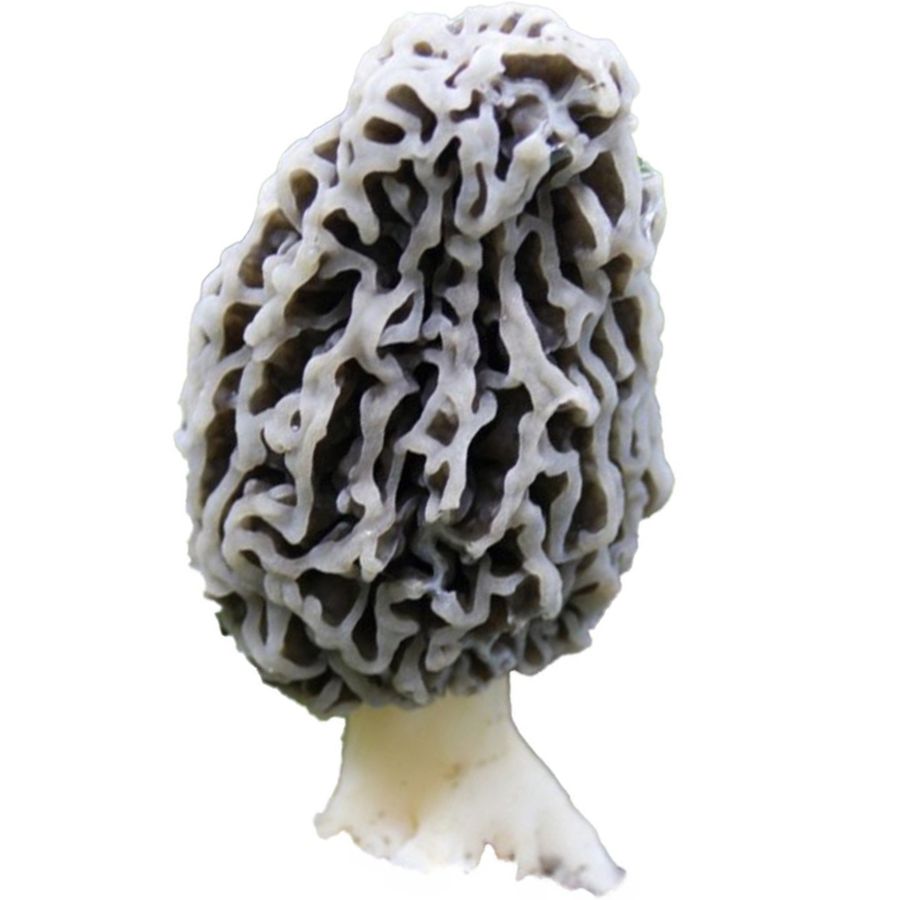
Grey morels (Morchella tomentosa) are also called fuzzy foot or fire morels. Their color can range from deep gray to blackish. They tend to grow in areas that have recently experienced wildfires, as they thrive in the nutrient-rich soil left behind by the fires.
Their caps have a ridged, honeycomb-like texture, similar to other morels. However, grey morels have caps that are covered in fine, fuzzy hairs, so they generally feel velvety to the touch. This is a key thing that sets them apart from other types of morels.
The stem of a gray morel also tends to be stouter and thicker, with an off-white color that can sometimes have a yellow-tinge. In addition, its flesh also tends to be denser compared to the more delicate flesh of yellow morels.
Cream or Yellow Morels
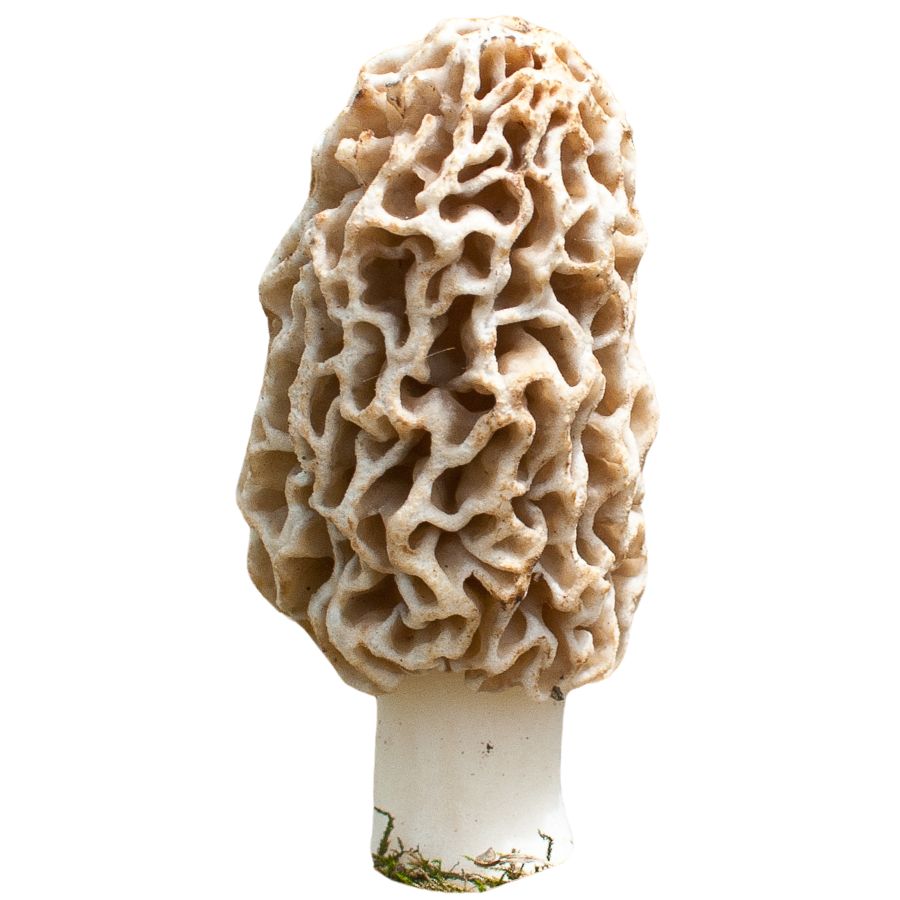
Yellow morels (Morchella esculenta), also known as common, cream, or sponge morels, are named for their yellowish or tan-colored caps. These morels have a honeycomb-like appearance, with deep ridges and pits. The ridges also tend to stay just a bit darker than the rest of the cap.
Pay close attention to the cap of the mushroom. The caps of yellow morels are characteristically fuller and rounder or oval-shaped. Also, their stems are hollow with a wide base and a pale creamy color.
This morel variety commonly grows in hardwood forests, especially near deciduous trees like ash, elm, and oak. They’re also one of the first morel varieties to appear in the spring.
Keep in mind that yellow morels start out with a more grayish appearance, gradually turning yellow as they grow older. This means that if you come across grayish morels in a hardwood forest, then they might be yellow morels that still need to mature.
Black Morels

Black morels (Morchella angusticeps), sometimes called eastern black morels, are a distinctive variety of morel mushrooms known for their dark, almost black caps. Their caps have the same honeycomb-like surface seen in other morels, but they are often taller and more slender.
You can also expect the ridges of this morel type to be noticeably darker than the pits. The stem can be off-white to pale yellow, and is typically wrinkly with a wider base.
This morel variety is often found in hardwood forests and old orchards. They thrive in moist soil and areas around decaying trees and plants as well as areas near streams and creeks. While they grow in moist environments, they don’t like overly wet soil.
You can also expect to black morels in the early to mid-spring, and they emerge just a bit earlier than yellow morels.
For a full overview of what wild mushrooms are easy to recognize, check out this resource on easy-to-identify wild mushrooms.
Mushrooms That Look Like Morels But Aren’t
Now that you have a better idea of what to keep an eye out for when you’re hunting for morels, you’ll also need to know which mushroom species you have to avoid.
Consider exploring foraging for survival strategies that include avoiding toxic lookalikes.
These mushroom species may look a lot like morels, but they’re not morels. Here are the morel lookalikes that you need to be able to identify:
Early Morel – Verpa bohemica
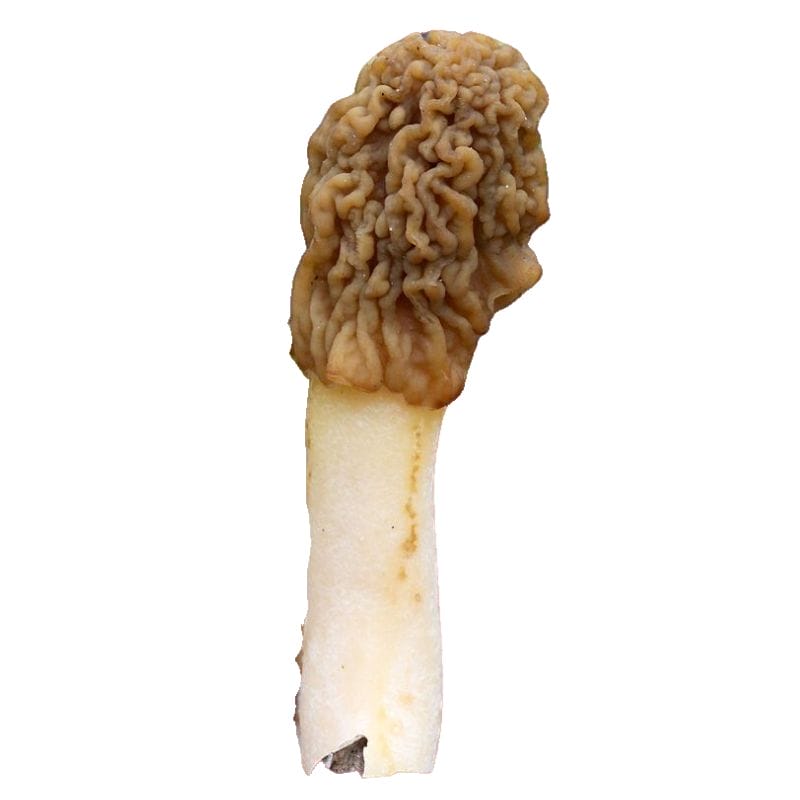
True to its name, the early morel (Verpa bohemica) is a morel lookalike that also emerges early in the spring. A lot of the time, it emerges even before true morels do! Add the fact that it looks like a morel to the unsuspecting eye, and it’s understandable that people often confuse it with the real thing.
The cap of the early morel is light brown or tan and looks kind of like a wrinkled thimble. It doesn’t have the distinctive ridges and deep pits that true morels have. The cap is also attached only to the top end of the stem, with the sides hanging over the stem, much like a bell.
Another difference between early morels and true morels is that early morels tend to have stems with fibers that look like cotton inside. The stems of true morels are generally hollow.
Can you eat the Verpa bohemica? The answer is…controversial, to say the least. Some say that these mushrooms are absolutely delicious and taste a lot like true morels. Others say that it’s fine and good enough to eat if you cook it for a long time. There also are those who only eat the stems and dispose of the caps.
In recent years, however, respected experts like Noah Siegel and Christian Schwarz, authors of Mushrooms of the Redwood Coast, have re-evaluated these fungi. They now list Verpa conica and Verpa bohemica as plain old “edible”—no scare quotes, no special warnings.
Globally, Verpa mushrooms are commonly eaten and even sold commercially without issue. Much of the lingering stigma seems to stem from U.S.-based caution, often due to a lack of deeper knowledge. For a thorough look at this debate, check out the detailed coverage by Fungi Magazine.
Bell Morel – Verpa Conica
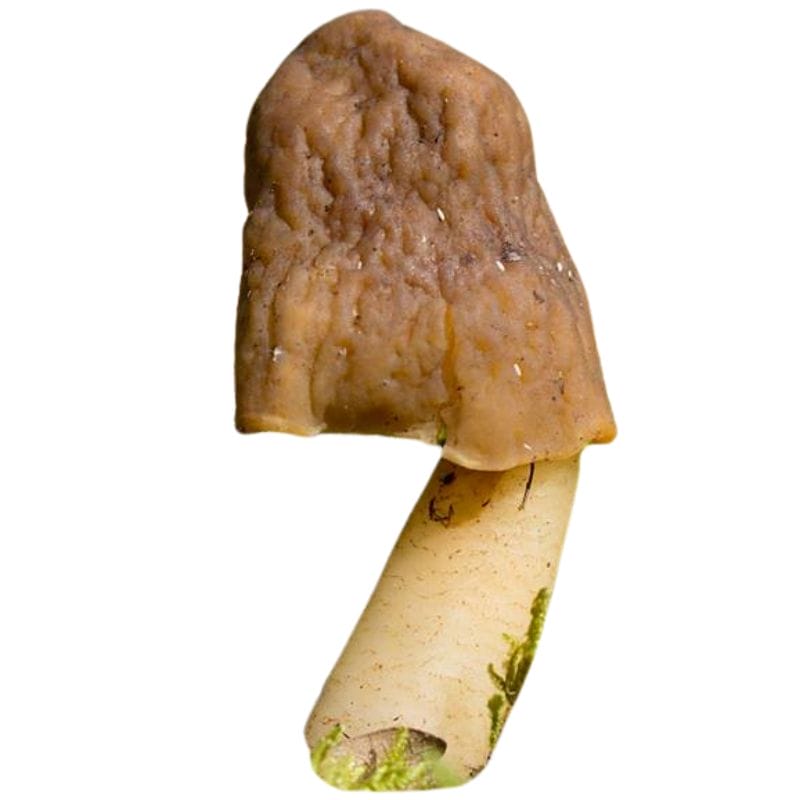
Like early morels, the bell morel (Verpa conica) is also easy to confuse as a true morel. However, it does have a few distinguishing characteristics.
Notably, the cap of bell morels is more similar to the cap of early morels. The cap is attached only to the top end of the stem, with the sides hanging down. It looks a lot like a bell — hence the name!
However, unlike the cap of early morels, the cap of bell morels doesn’t have a wrinkled appearance.
The stem of the bell morel is white to pale yellow, and also longer and narrower compared to the stems of true morels and early morels. It also has a smoother and more fibrous texture, though it has a similar cottony interior as early morel stems.
As a general rule, bell morels should be cooked thoroughly before consumption. If you’re eating it for the first time, it’s best to only eat small portions at first to test your tolerance and avoid gastrointestinal issues.
False Morel – Gyromitra esculenta

False morels (Gyromitra esculenta) are a type of mushroom that you definitely need to watch out for. It’s a toxic mushroom that unfortunately looked quite similar to true morels. Luckily, there are key differences between true and false morels that can help you set the two apart.
One thing that you might be able to notice right away is the appearance of the cap. The cap of a false morel is wrinkled, not sharply ridged and pitted like the cap of a true morel. You’ll also notice that false morel caps are wider where true morel caps are narrower.
Overall, false morels look a lot like brains.
In addition, false morels have a reddish brown to dark brown color, sometimes tinged with yellow or tan. The stem also tends to be short and thick, with an off-white to yellow color and a cottony, fibrous interior.
An important characteristic that sets false morels apart from true, early, and bell morels is that false morels are hollow but chambered. True, early, and bell morels are hollow all throughout. False morels, meanwhile, have several hollow pockets inside of them.
Perhaps the most important thing to remember about false morels is that they’re known to be toxic, especially when they’re raw. They contain a compound called gyromitrin, which breaks down into monomethylhydrazine (MMH) when consumed. MMH can affect major organs in the body and cause severe poisoning.
There are those who still consume false morels after extensive cooking and preparation, but it’s important to keep in mind that these mushrooms can still be highly toxic even when cooked. Thus, it’s best to stay away from false morels and to leave them be when you encounter them.
Stinkhorn

Stinkhorns are a group of mushrooms that certainly live up to their name. Aside from their distinctive appearance, they also have a distinctive smell. They have a strong, foul odor that’s often compared to the smell of rotting meat or even sewage. In fact, the smell alone can help you distinguish them from true morels.
Several stinkhorn species have a slimy mass on their caps. This mass is the gleba, or the spore mass. Because stinkhorns emit a foul, rotting smell, the often attract flies that then carry off the spores and spread them.
The caps of stinkhorns themselves are often slimy to the touch as well, as opposed to the dry caps of true morels. Depending on the species, stinkhorn caps can be pointed, rounded, or latticed. Stinkhorn are also soft and spongy, while true morel caps are firmer.
You can also differentiate between stinkhorns and true morels based on their habitats. While true morels generally thrive in hardwood forests and post-burn areas, stinkhorns grow in things like mulch, compost, and areas with decaying wood. They also prefer warm and humid environments.
How To Find Morels
Let’s get more specific and break down the different conditions in which morels can typically be found:
Know your trees if you want to find morels
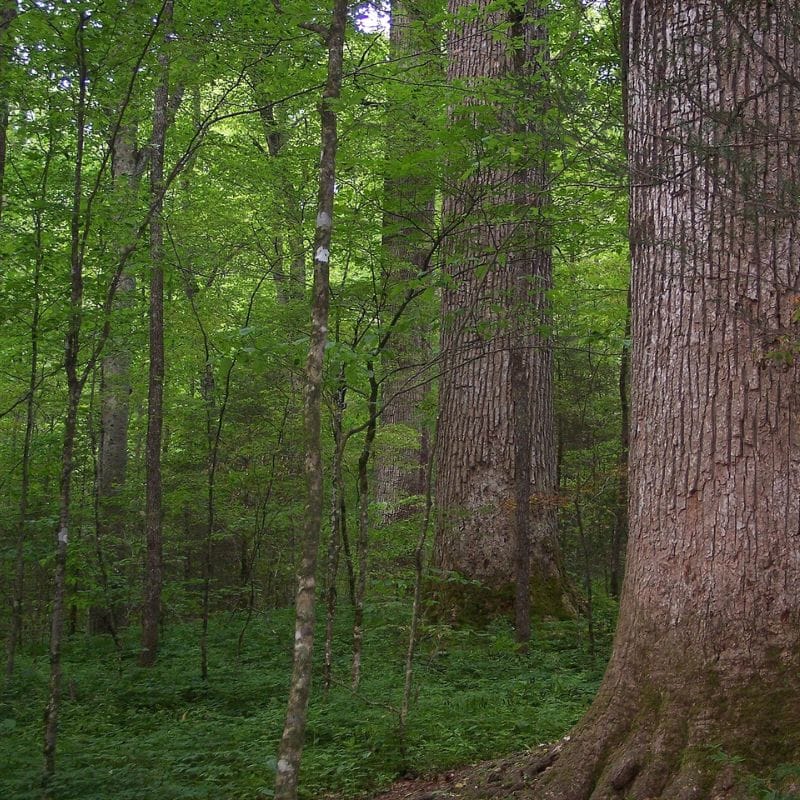
The most common type of trees associated with true morels are hardwood trees. You’ll often find morels at the base of these trees, around fallen leaves, or near decaying roots.
Keep an eye out for the following tree types:
- Apple
- Ash
- Aspen
- Douglas Fir
- Elm
- Oak
- Peart
- Ponderosa Pine
- Sycamore
- Tulip Poplar
- White Pine
If you need a refresher on how to identify these, you can check out this article on how to identify the trees morels love here.
Loamy or moist and well-drained soils around these trees are usually the best spots where morels can be found.
Coniferous trees are often associated with morels, though these are for fire-associated varieties. You can search for morels in conifer forests in the aftermath of a fire.
Moist soil near creeks and streams are ideal

You’ll also be able to find morels in rich, moist soils near streams and creeks, especially those on hillsides.
However, it’s important to note that the area should have well-drained soil. That’s the type of soil that morels thrive in. You’re far less likely to find these mushrooms in wet, inundated soil.
Thus, when you’re near a stream or creek, try to go a bit farther away and look for spots where the soil drainage is much better.
Seek Out Old Apple Orchards

Morels notoriously thrive in old apple orchards, especially orchards in regions where apples have been historically cultivated. This is because morels are known to favor areas with decaying organic matter from dead or dying trees, and apple orchards are a prime candidate.
These old orchards often have decaying apple tree roots. The soil there is also often rich in nutrients and is well-drained, forming a great environment for morels to form.
Additionally, apple orchards have disturbed ground as a result of tilling and the removal of trees. This is yet another condition that morels prefer.
However, one caveat is that old apple orchards, especially those from the early to mid-20th century, were typically treated with pesticides like DDT and lead arsenates. These pesticides have been banned, but they’re still a concern. DDT takes a long time to break down, and lead isn’t biodegradable at all.
Thus, old apple orchards might be contaminated with these pesticides.
If you’re looking to broaden your spring foraging knowledge, these simple foods to forage in spring can be found in many of the same environments as morels.
Soil temperature is critical

Another environmental aspect that’s crucial for the growth of morels is soil temperature. Typically, the most ideal temperatures for morels to thrive are 50°F to around 55°F.
Morels might start appearing once temperatures reach around 48°F, continuing to thrive once temperatures are in the ideal range. They can still continue growing in the 55°F to 60°F range.
However, if temperatures rise too quickly, that might signal the end of morel season. Anything above 60°F will cause morels to begin to dry out and decay.
Focus on southward and westward slopes early in the season
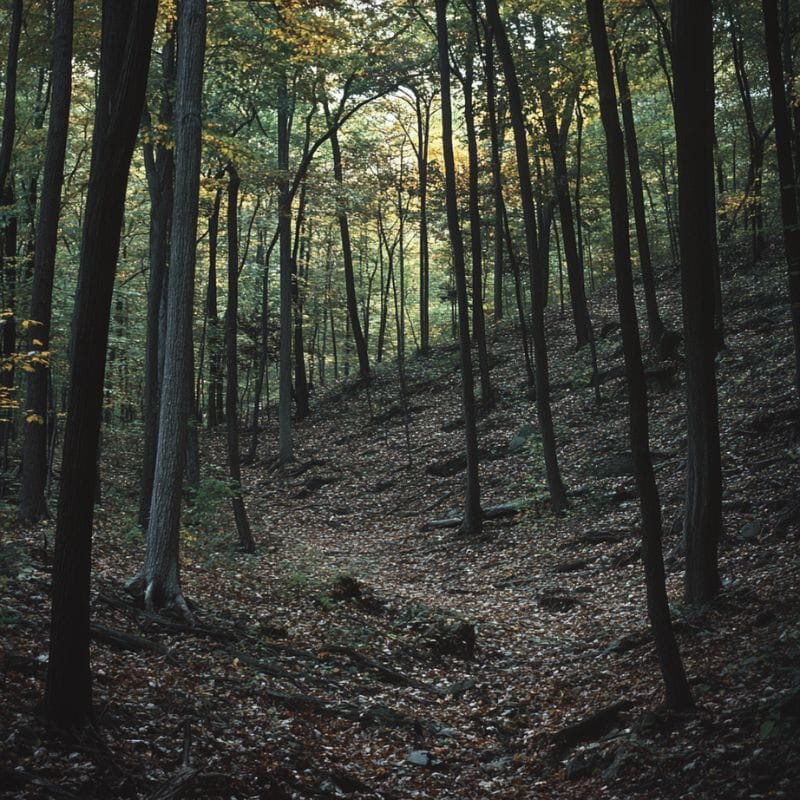
Morels tend to show up sooner on south- and west-facing slopes. This is because these slopes generally receive more direct sunlight, which makes them warm up faster in the spring. Thus, the soil here reaches the ideal 55°F to 60°F temperature range more quickly.
If you want to go morel hunting earlier in the season, you can check out south- and west-facing slopes. However, morels in these areas tend to be smaller and drier because of the higher temperatures.
Wait a little longer and you can hunt on north- and east-facing slopes. These areas won’t get as much direct sunlight and therefore warm up more slowly. Soils here also retain moisture much longer.
Thus, morels tend to be larger on north- and east-facing slopes, and they typically stick around for a longer period of time.
Burned areas are great for some morels
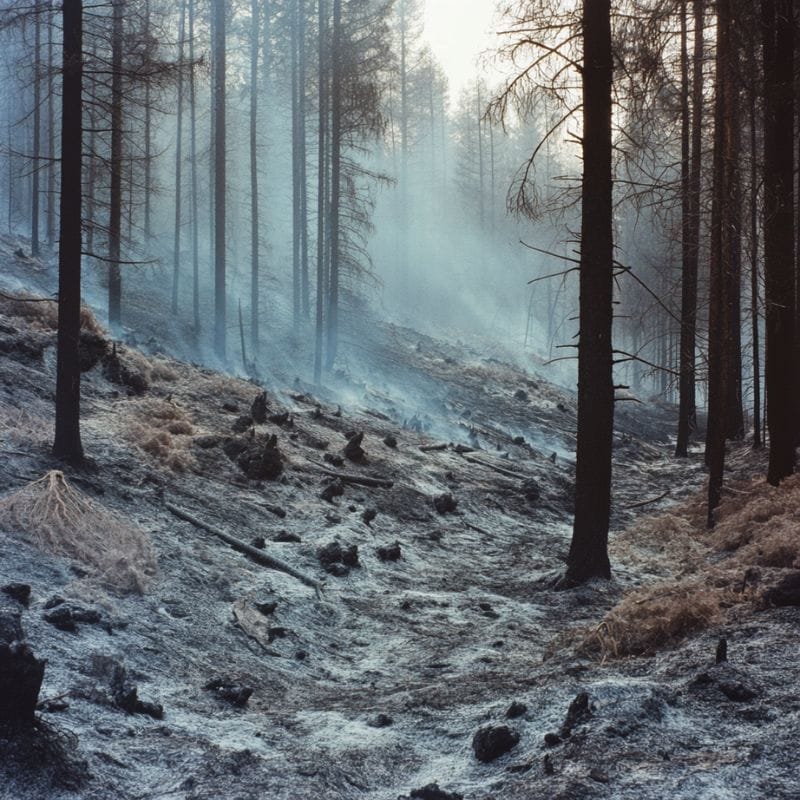
Burn areas are also a great place for morels to grow in, particularly those areas in the western US where wildfires occur frequently. You can expect morels to grow during the first spring following a wildfire.
Fire can give morels an advantage. For one thing, it can wipe out other fungi and plants that would compete with morels for nutrients. Morels also thrive in disturbed ground, of which there are plenty after a fire.
However, morels won’t thrive if the fire is too intense. The fire should just be intense enough that it can clear the forest floor without being so hot that it sterilizes the ground.
Tools from the ultimate forager’s toolkit can make searching in post-fire terrain much easier.
Rotting wood debris and leaves
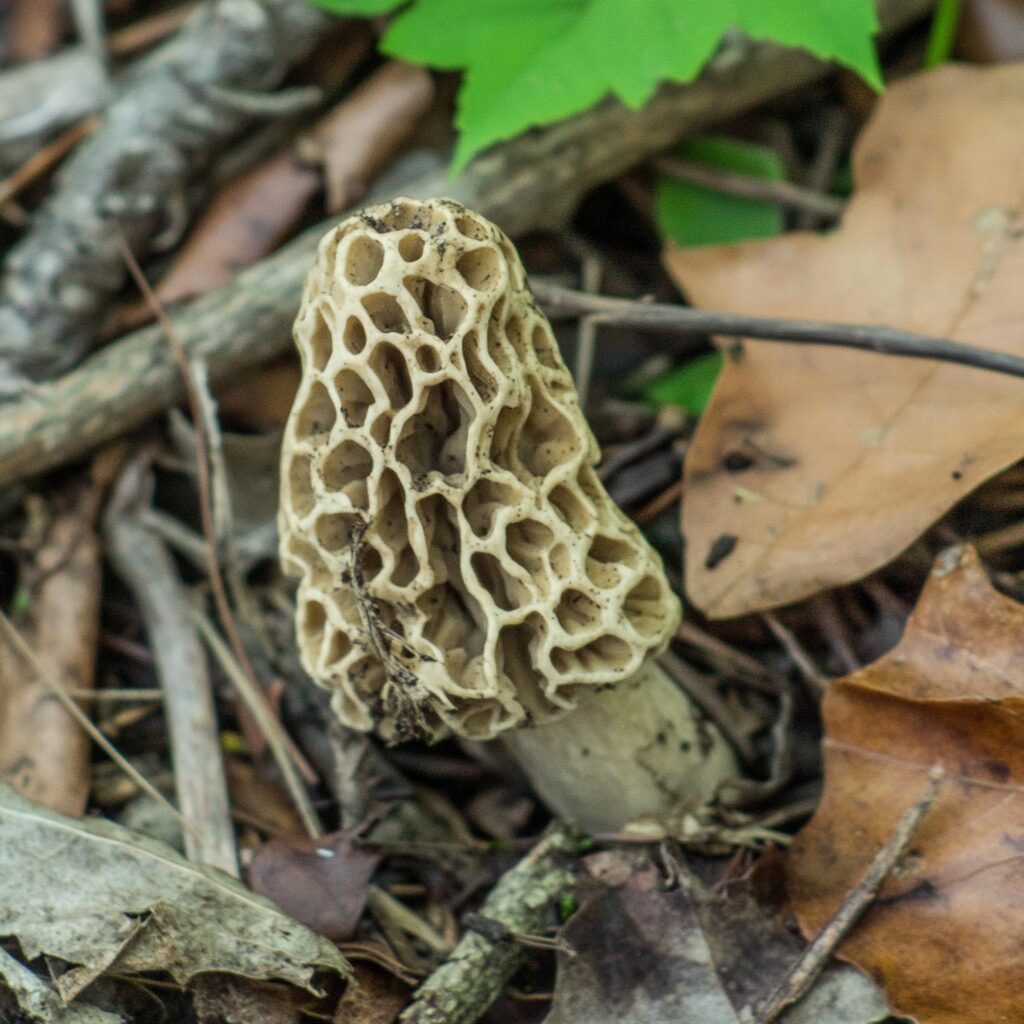
Look for spots where there are dead or dying trees, fallen branches, or fallen leaves. The roots and stumps of elm, poplar, ash, apple, and other types of hardwood trees in particular are also good places to look. These are prime spots for morels because decaying organic matter enables these mushrooms to thrive.
Decomposing leaves, wood, and roots release nutrients that fuel the growth of morels and other types of fungi. Decaying matter also holds the right amount of moisture that morels prefer.
When you see one there are often others nearby
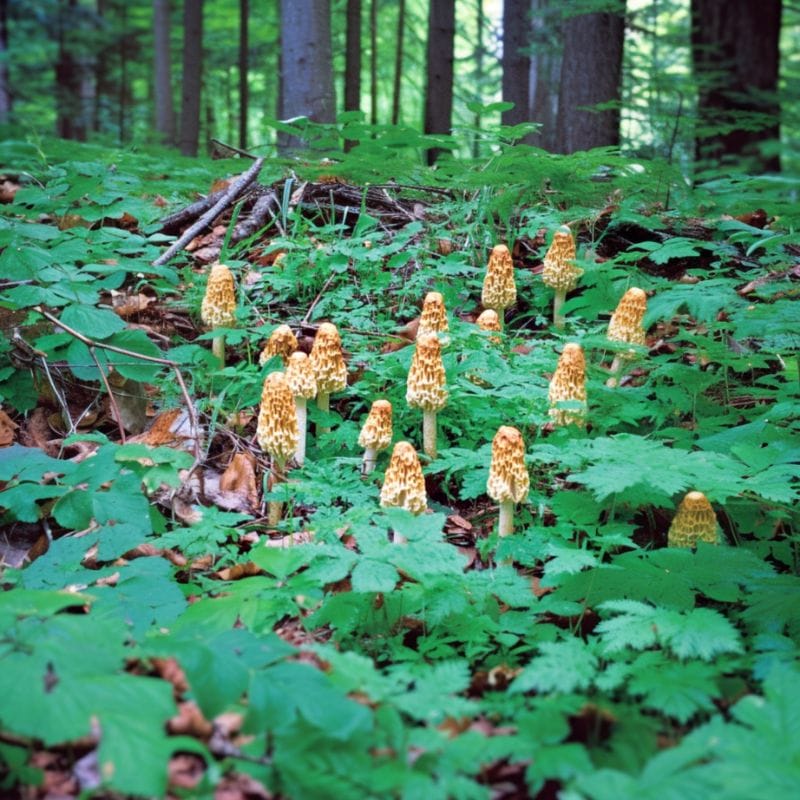
There’s rarely ever just one morel in a general area. Typically, they appear in small clusters. If you find one, it’s highly likely that there are more nearby, often within a distance of a few feet. You won’t find morels tightly packed together, but you won’t have to look far either for more specimens.
Morels can also return to the same spots year after year, though this is highly dependent on the conditions in the area. As long as all the right environmental conditions are there, you can come back to the same spots where you found morels every year. There will likely be more morels waiting.
It’s also possibly that these spots might shift slightly as time passes. Drastic changes, such as fires and floods, can also increase the chances of morels fruiting.
Old timers look to oak leaves and lilacs
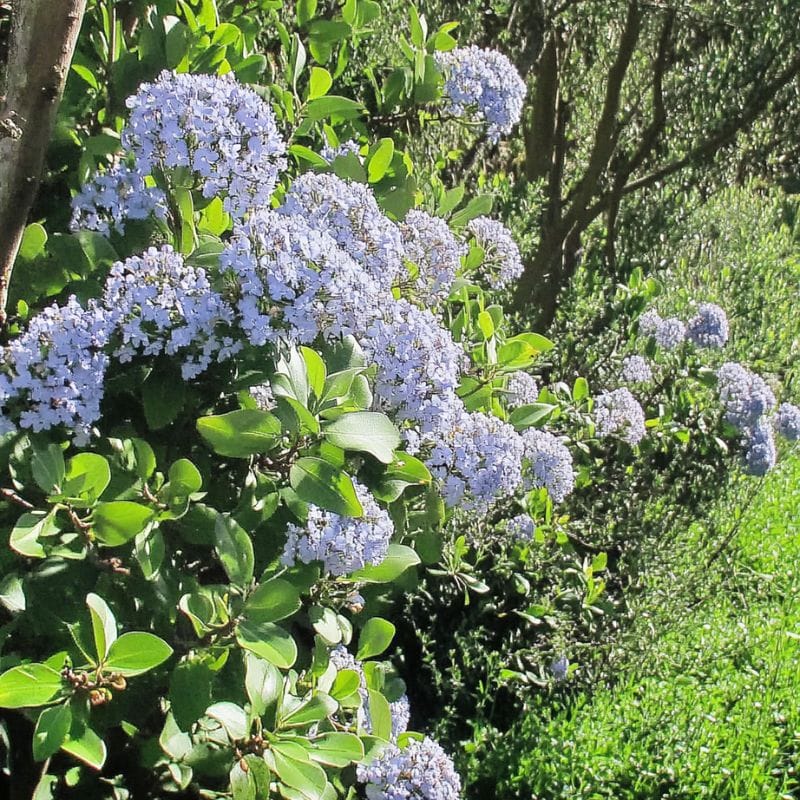
Experienced foragers will likely tell you to keep an eye out for lilac blooms. This is because the conditions needed for morels to grow and lilacs to bloom are generally aligned. You’ll likely hear that morel season coincides with the blooming of lilacs, especially in temperate areas.
The emergence of oak leaves is also a traditional indicator for morel season, and with good reason. Oak leaves come out when temperatures reach the 50°F to 55°F range, so morels are not far behind. Once these leaves are roughly the size of a mouse’s ear, it’s time to start looking!
Before you head out
Before embarking on any foraging activities, it is essential to understand and follow local laws and guidelines. Always confirm that you have permission to access any land and obtain permission from landowners if you are foraging on private property. Trespassing or foraging without permission is illegal and disrespectful.
For public lands, familiarize yourself with the foraging regulations, as some areas may restrict or prohibit the collection of mushrooms or other wild foods. These regulations and laws are frequently changing so always verify them before heading out to hunt. What we have listed below may be out of date and inaccurate as a result.
Where You Can Find Morels
Armed with the knowledge of the typical places where morels can be found, we can now take a look at the places where you can go mushroom hunting successfully.
If you’re hoping to find other spring edibles along the way, these easy-to-identify wild roots and tubers are often found in the same environments.
These are some of the best spots for morels in the state:
Umpqua National Forest
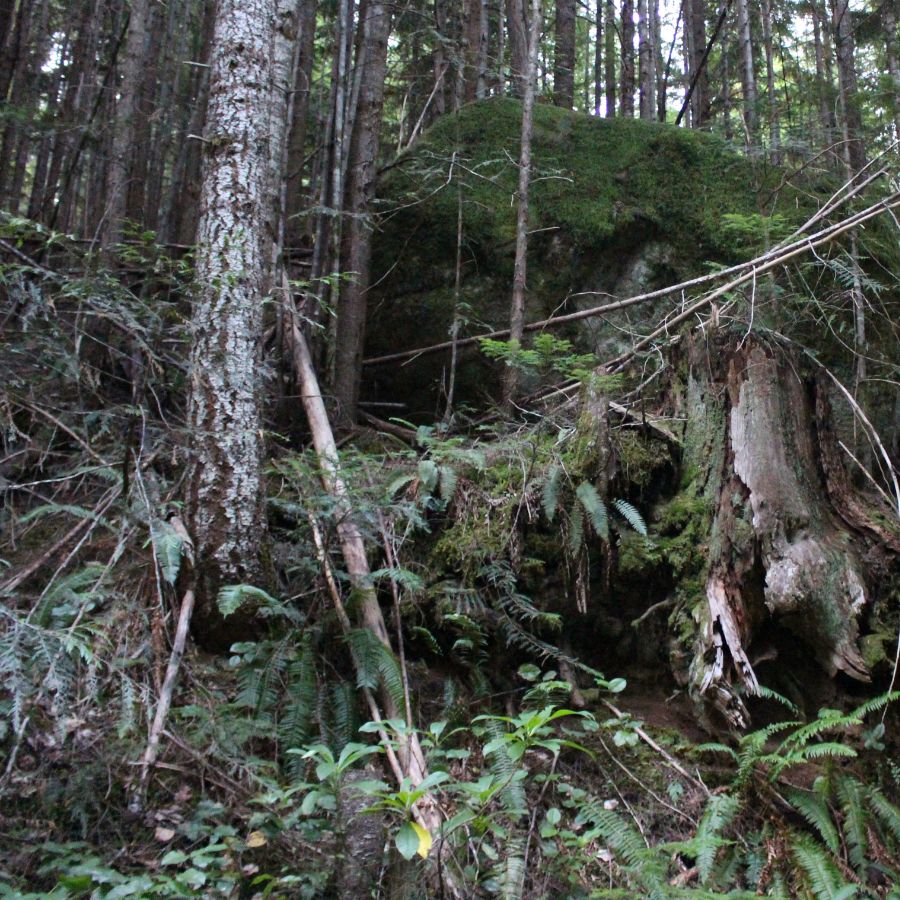
Umpqua National Forest spans nearly one million acres across the western slopes of the Cascade Mountains. Famous for its dramatic waterfalls along the North Umpqua River, this diverse ecosystem attracts outdoor enthusiasts year-round. The forest’s varied terrain rises from 2,000 feet to over 9,000 feet at Mount Thielsen.
The nutrient-rich soil created by forest fires makes this an ideal environment for morel mushrooms to thrive.
When hunting for morels in Umpqua, focus on areas that experienced fires one to two years ago. These post-burn environments often produce abundant morel flushes in the spring season.
Also, look around dying or dead elm trees and old apple orchards which can be found scattered throughout the lower elevations of the forest. The forest’s varied elevation means that morels can be found at different times as the season progresses.
Mt. Hood National Forest
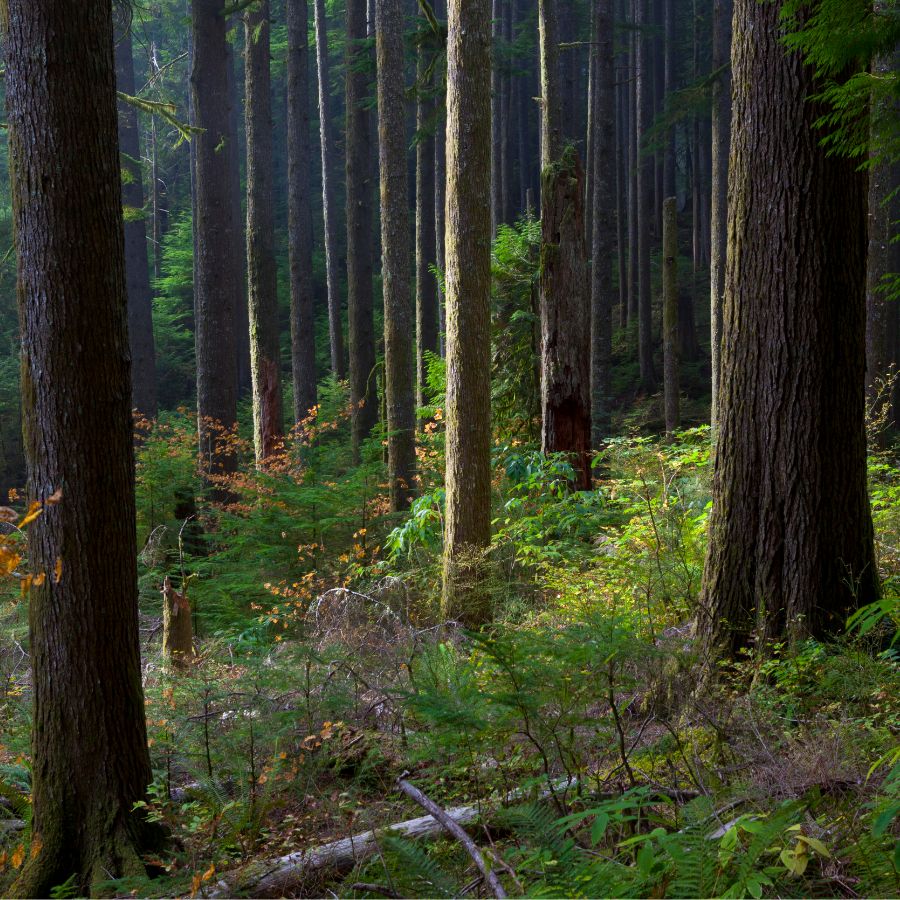
Mt. Hood National Forest encompasses the iconic 11,249-foot volcanic peak that dominates Portland’s eastern skyline. Located just 20 miles east of the city, this million-acre wilderness stretches across the Cascade Range with dense Douglas fir forests, alpine meadows, and crystal-clear lakes.
The forest’s accessibility from Portland makes it a convenient destination for urban foragers seeking a day trip adventure.
For the best morel hunting experience, explore the eastern slopes of Mt. Hood, where conditions tend to be drier and warmer. Check around areas with cottonwood trees and dying elms.
The forest’s numerous recently thinned timber areas also make excellent hunting grounds. Natural burn sites from lightning strikes can be particularly productive spots. The forest service roads provide good access to many promising areas without requiring lengthy hikes.
Willamette National Forest
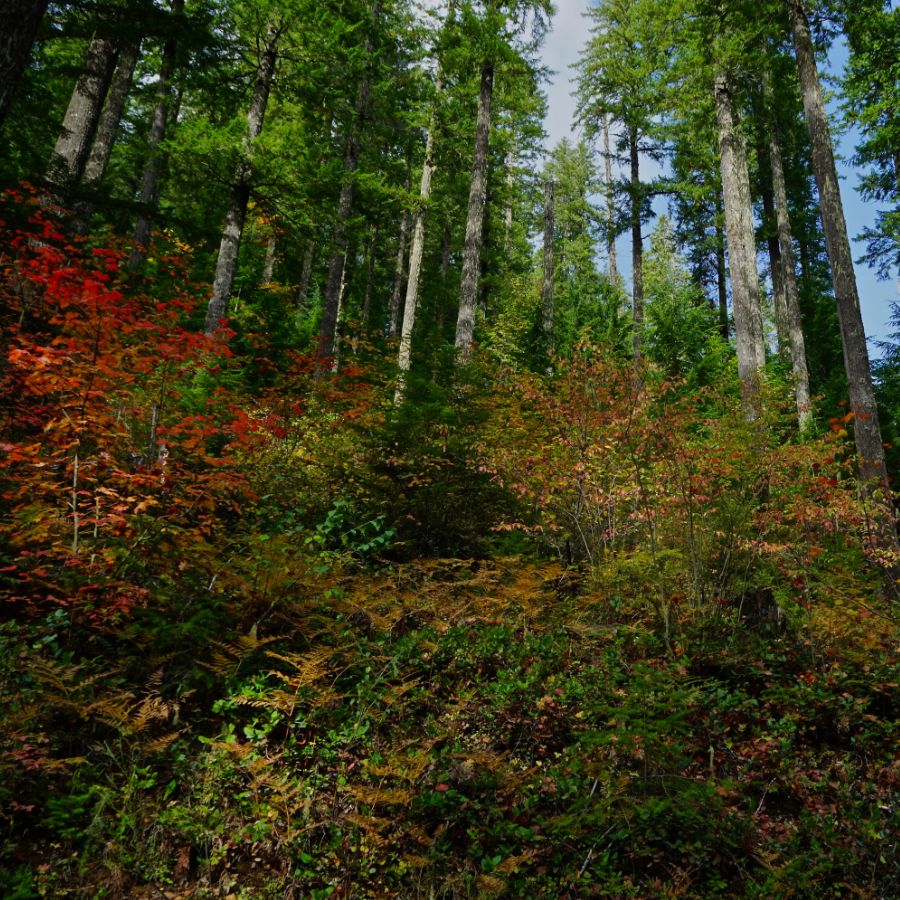
The Willamette National Forest is a verdant paradise nestled between Eugene and Salem. Home to eight wilderness areas, this 1.6-million-acre forest features some of the tallest trees in the Pacific Northwest.
Ancient volcanic activity has shaped this landscape, creating hot springs and impressive lava fields that attract geology enthusiasts alongside mushroom hunters.
Also, the forest’s abundant rainfall creates perfect moisture conditions for fungal growth of all kinds. Look for south-facing slopes at middle elevations where the ground warms earlier in the season.
Experienced foragers particularly value this location for its consistent morel production even outside of burn areas. The H.J. Andrews Experimental Forest section is known among locals as having particularly good morel patches.
The numerous campgrounds throughout the forest make it convenient for multi-day foraging trips.
Deschutes National Forest
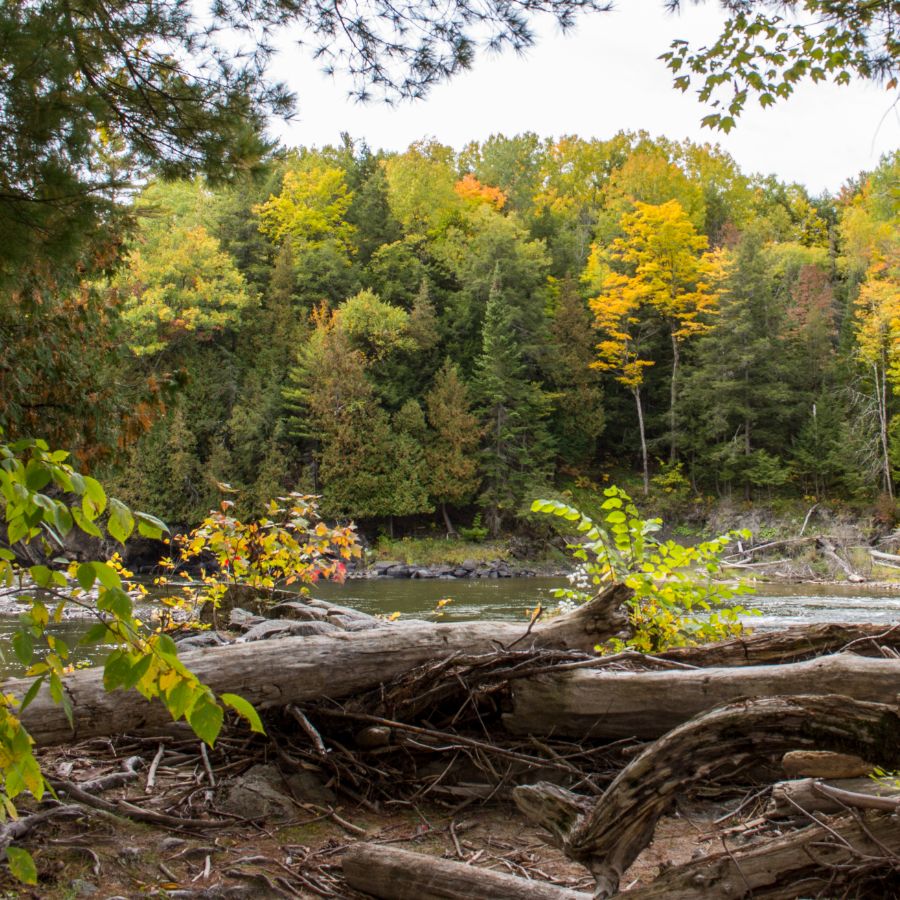
Deschutes National Forest lies in central Oregon, stretching from the town of Sisters to just south of Bend. Named after the magnificent Deschutes River that winds through it, this forest showcases Oregon’s transition zone between mountain forests and high desert plateaus.
The forest’s transition ecology creates ideal temperature and moisture gradients that morels thrive in. Mixed conifer stands with both ponderosa pine and fir trees often harbor good morel populations.
Also, check around the edges of meadows and clearings where trees provide some shade but allow enough sunlight to warm the ground.
This area receives less rainfall than forests on the western side of the Cascades, creating different growing conditions that many morel varieties actually prefer.
The Sisters Wilderness area has historically been productive for morel hunters after fire events. The forest’s extensive road system makes it relatively easy to access promising hunting areas even for those with limited mobility.
Malheur National Forest
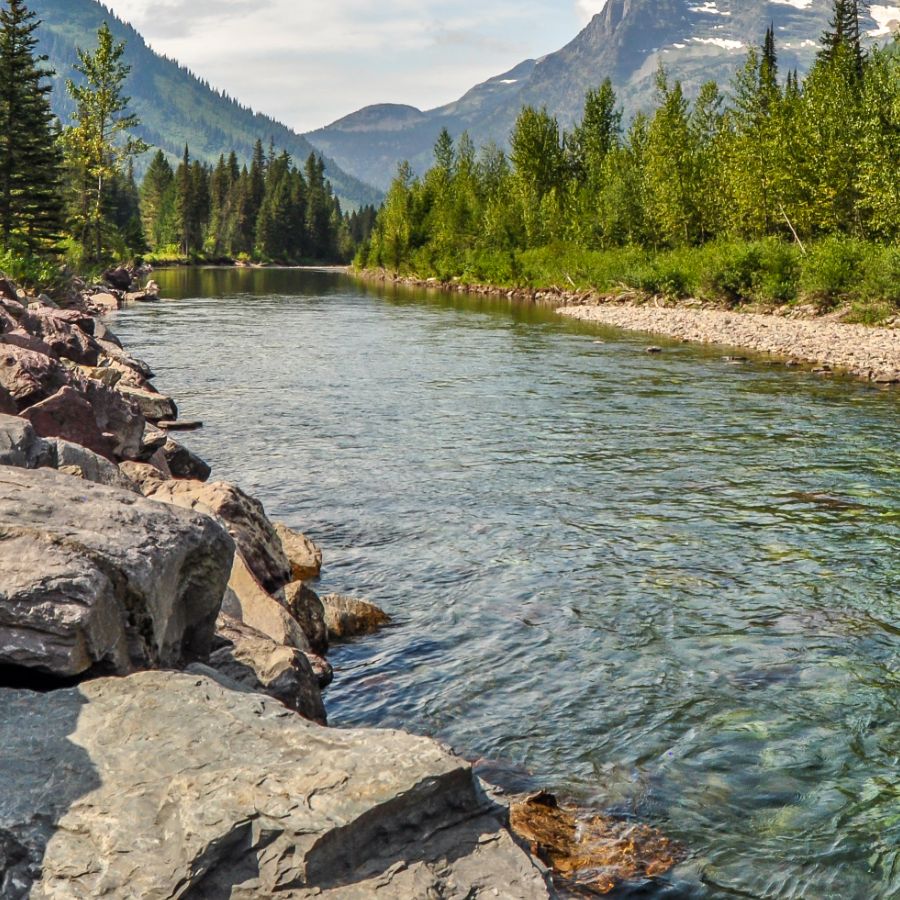
Malheur National Forest sits in the heart of eastern Oregon’s Blue Mountains, roughly 200 miles east of Bend. This remote wilderness boasts the largest stand of old-growth ponderosa pines in the nation.
The forest encompasses both the Strawberry Mountain and Monument Rock wilderness areas, offering solitude rarely found in more accessible forests. Indigenous peoples harvested foods here for thousands of years before European settlement.
The forest’s mosaic of tree species creates diverse growing environments where morels thrive. Areas around the Strawberry Mountain Wilderness are known to be particularly productive.
To maximize your morel harvest in Malheur, target north-facing slopes at lower elevations early in the season. Look along the edges of melting snow patches where soil moisture is perfect for morel growth.
Local foragers recommend checking around stands of old-growth ponderosa pines where the needle bed creates the slightly acidic soil conditions that morels favor.
Additional locations to find Morels
| Northwestern Oregon | Collection Allowance |
|---|---|
| Clatsop State Forest | Harvesting is allowed for personal use without a permit. |
| Columbia County State Parks | Collection is permitted for personal consumption; specific limits may apply. |
| Forest Grove District | Personal collection is allowed; check local regulations for any restrictions. |
| Gales Creek | Mushroom picking is permitted for personal use; observe any posted guidelines. |
| L.L. Stub Stewart State Park | Gathering is allowed for personal consumption; adhere to any posted limits. |
| Tillamook State Forest | Collection for personal use is permitted; observe any posted guidelines. |
| Vernonia | Personal collection is allowed; check for any posted restrictions. |
| Wilson River Corridor | Harvesting is permitted for personal use; adhere to any posted guidelines. |
| Southwestern Oregon | Collection Allowance |
|---|---|
| Coos Bay District BLM Lands | Up to 1 gallon per person per day is allowed for personal use without a permit. |
| Elliott State Forest | Personal collection is permitted; check for any posted restrictions. |
| Rogue River-Siskiyou National Forest | Harvesting is allowed for personal use; permits may be required for larger quantities. |
| Umpqua National Forest | Collection for personal consumption is permitted; observe any posted guidelines. |
| Central Oregon | Collection Allowance |
|---|---|
| Deschutes National Forest | Personal collection is allowed; a permit is required for quantities exceeding 1 gallon per day. |
| Fremont-Winema National Forest | Collection for personal use is permitted; permits are necessary for larger quantities. |
| Ochoco National Forest | A free-use permit allows gathering up to 2 gallons per person per day; obtain permits at local Ranger Stations. |
| Prineville District BLM Lands | Personal collection is allowed; check local regulations for any restrictions. |
| Eastern Oregon | Collection Allowance |
|---|---|
| Baker County State Parks | Collection is permitted for personal use; adhere to any posted guidelines. |
| Malheur National Forest | Harvesting is allowed for personal consumption; permits may be required for larger quantities. |
| Umatilla National Forest | Personal collection is permitted; observe any posted restrictions. |
| Wallowa-Whitman National Forest | Collection for personal use is allowed; check for any posted guidelines. |
| Western Oregon | Collection Allowance |
|---|---|
| Alsea Falls Recreation Area | Personal collection is permitted; adhere to any posted guidelines. |
| Benton County State Parks | Harvesting is allowed for personal use; observe any posted restrictions. |
| Eugene District BLM Lands | Collection for personal consumption is permitted; check local regulations for any restrictions. |
| Marys Peak Recreation Area | Personal collection is allowed; adhere to any posted guidelines. |
| Siuslaw National Forest | No permit is required for collecting less than 1 gallon per person per day; permits are necessary for larger quantities. |
| Willamette National Forest | Personal collection is permitted; a permit is required for quantities exceeding 1 gallon per day. |
| Northern Oregon | Collection Allowance |
|---|---|
| Clackamas County State Parks | Harvesting is allowed for personal use; observe any posted restrictions. |
| Hood River County State Parks | Collection for personal consumption is permitted; check local regulations for any restrictions. |
| Mt. Hood National Forest | A free-use permit allows harvesting up to 1 gallon per day, with a total limit of 10 gallons |
| Southern Oregon | Collection Allowance |
|---|---|
| Applegate Valley BLM Lands | Up to 1 gallon of mushrooms per person per day for personal use is allowed without a permit. |
| Jackson County State Parks | Gathering up to 5 gallons per person per day for personal use is allowed unless otherwise posted. |
| Josephine County State Parks | Gathering up to 5 gallons per person per day for personal use is allowed unless otherwise posted |
When You Can Find Morels
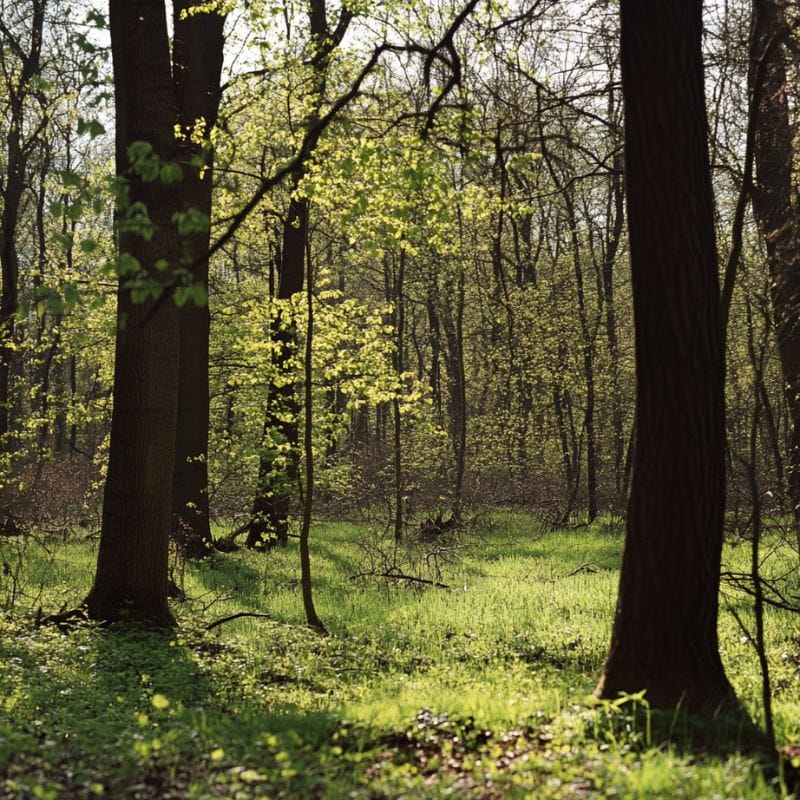
Morel mushrooms are known to show up in the spring, but exactly when is the question. The timing of morel season can vary, depending on the location, weather conditions, temperature, and various other factors.
In some areas, morels start emerging as early as the first few warm days after winter. If you’re in the southern United States, you might want to start morel hunting as early as March. If you’re in the northern parts of the country, such as the Midwest or the Northeast, you might have to wait until April to May.
Morels emerge later in the spring in some mountain regions, where morels season might continue up to early June. Typically, you can also expect fire morels to appear in the latter parts of spring.
Generally, you’ll want to hunt for morels a few days after some light rainfall, when temperatures start to get warmer. You can keep an eye on local weather forecasts, and you can also start checking soil temperatures if you haven’t done so yet. This can give you a much better idea of whether or not it’s time to put on your boots and start searching.
If you live in an area where wildfires occur, you might be able to start successfully searching for morels a day or two after a fire. However, keep in mind that other environmental conditions also need to be just right for morels to start fruiting. You might have to wait until later in the season, particularly in higher elevations.
It’s important to get the timing right! Morel season doesn’t last long, typically 4 to up to 8 weeks. This can also depend on a lot of different factors, many of which you can track and predict.
Thus, you need to make sure that you’re familiar with the topography and landscape of the area where you want to search, the weather, the environmental conditions, and the specific things that are conducive for morel growth. Make sure to get in early before all the good spots get wiped out!
As you head into peak season, it’s also worth learning about easy-to-identify wild nuts, seeds, and berries to round out your foraging haul.
One Final Disclaimer
The information provided in this article is for general informational and educational purposes only. Foraging for wild plants and mushrooms involves inherent risks. Some wild plants and mushrooms are toxic and can be easily mistaken for edible varieties.
Before ingesting anything, it should be identified with 100% certainty as edible by someone qualified and experienced in mushroom and plant identification, such as a professional mycologist or an expert forager. Misidentification can lead to serious illness or death.
All mushrooms and plants have the potential to cause severe adverse reactions in certain individuals, even death. If you are consuming foraged items, it is crucial to cook them thoroughly and properly and only eat a small portion to test for personal tolerance. Some people may have allergies or sensitivities to specific mushrooms and plants, even if they are considered safe for others.
Foraged items should always be fully cooked with proper instructions to ensure they are safe to eat. Many wild mushrooms and plants contain toxins and compounds that can be harmful if ingested.


